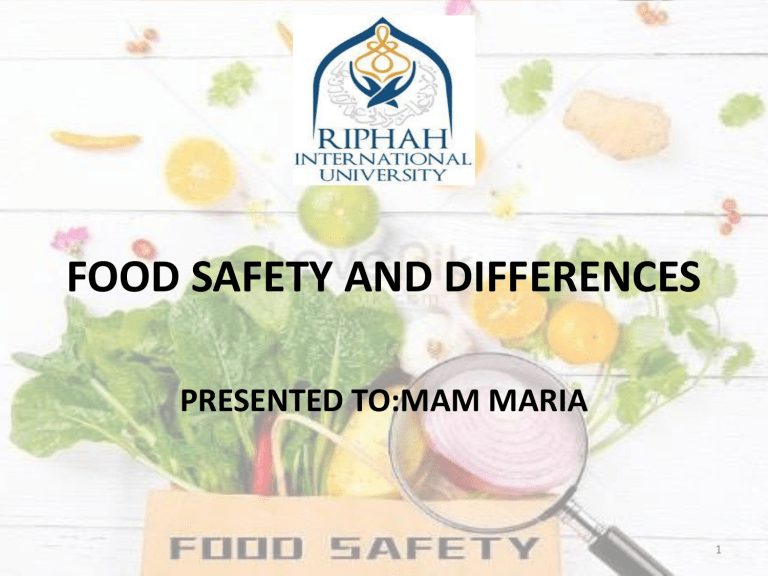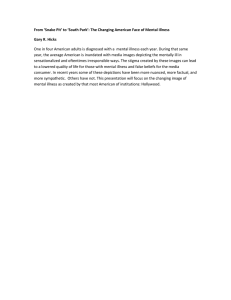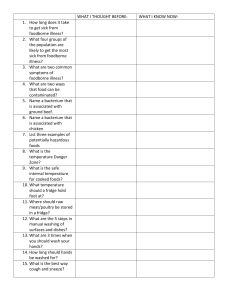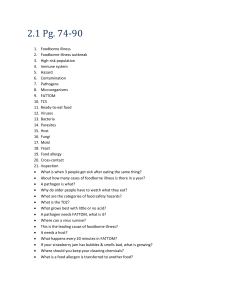
FOOD SAFETY AND DIFFERENCES PRESENTED TO:MAM MARIA 1 PRESENTED BY NAYYAB NOOR IFRAH AMEER MEMOONA IBRAR HAREEM IFTHIKHAR ANEESA SHAHEEN RIJA ZAHEER QURATULAIN NOOR 2 INTRODUCTION FOOD BORNE ILLNESS FACTOR EFFECT FOOD SAFETY FOOD SAFETY FOOD SAFETY IN DIFFERENT SETTING GLOBAL DIFFERENCES FOOD PRESERVATION METHODS FOOD SAFETY CHALLENGES 3 INTRODUCTION • “Food safety (or food hygiene) is a scientific method/discipline that describes how to handle, prepare, and store food in order to avoid food-borne illness” FOOD SAFETY IN DIFFERENT SETTING • 31 oct 2020 44 sick and I dead in us because of two e coli out breaks FOOD SAFETY CHALLENGES • 30 jul 2020 826 sick 1 child dead in jordan due to food poisoning • 14 jun 2019 5 patient died in England due to listeria containing sandwich 4 WHAT IS FOOD SAFETY • Food safety is the scientific and practical approach of handling, preparing, and storing food to prevent illness and ensure it remains wholesome for consumption. • Types of food • High risk food • Low risk food • Raw foods • Ready to eat raw foods 5 FOOD BORNE ILLNESS • Foodborne illness is caused by consuming contaminated foods or beverages. Many different diseasecausing microbes or pathogens can contaminate foods, so there are many different types of food borne illnesses. . 6 SYMPTOMS Food borne illness cause: Food borne illness treatment 7 FACTOR EFFECTING FOOD SAFETY • Several factors influence food safety, including proper storage, thorough cooking, hygiene during food handling, avoiding crosscontamination, and ensuring the freshness of ingredients. Regular cleaning of kitchen surfaces and utensils, as well as adherence to food expiration dates, also play crucial roles in maintaining food safety 8 Including some factors: Food handling and preparation Food source Storage conditions Cross contamination Food packaging 9 FOOD SAFETY IN DIFFERENT SETTING • Food safety is crucial in various settings to prevent foodborne illnesses. Here are some considerations for different settings: 1-Home Kitchen • Practice good hygiene • Cook to the right temperature: 2-Restaurant • Staff training • Cross-contamination prevention 3-Street Food Stalls • Choose reputable vendors • Observe food handling 10 CONT.. 4-School Cafeterias • Safe food handling • Allergen awareness 5-Hospitals • Special diets • Sanitization 6-Grocery Stores • Product rotation • Refrigeration 11 GLOBAL DIFFERENCES IN FOOD SAFETY • Food safety standards and regulations can vary significantly from one country to another. These differences are influenced by factors such as cultural practices, government policies, and the level of economic development. Here are some key global differences in food safety: • Regulatory Bodies: • (FDA),(EFSA),(FSSAI) • Standard and Guidelines: • (FAO),( WHO) 12 Cont.. • Food additives and Ingerdients • Labelling requirements • Includes information such as nutrition facts, ingredient lists, allergen declarations, and date labelling (e.g., “use by” or “best before” dates). • Pesticide residue limits • Food borne illness reporting • Food handling and prepration practices 13 FOOD PRESERVATION METHODS • “Food preservation can be defined as the process of treating and handling food in such a way to stop or greatly slow down spoilage and prevent food borne illness while maintaining nutritional value texture and flavour PASTEURIZATION • Louis pasture • It is a process of heat processing a liquid or a food to kill pathogenic bacteria to make food safe to eat • Example • Milk and juices • 70°C,15 to 30 seconds 14 FOOD PRESERVATION METHODS STERILIZATION • Joseph lister • “the process of eliminating all forms of bacteria including fungi,spores,virus and bacteria from food products by application of heat” 121°C,15 TO 30 minutes CANNING “Method of food preservation involves placing food into jar or similar container and heating them that destroy microorganism which cause food spoilage” • Example canned food 15 PRESERVATION BY LOW TEMPERATURE METHOD FREEZING: • “Freezing is an effective foam of food preservation because the pathogens that causes food spoilage are killed or don't grow rapidly at reduced temperature” • Long term frozen storage: (-18°C) • E.g. frozen food REFRIGERATION: Most common food preservation method • 0°C TO 5°C • E.g drinks ,meats ,fruit ,vegetables etc 16 EMERGING FOOD SAFETY CHALLENGES In recent years, the following new problems to food safety have emerged: • Food borne illness outbreaks: Sickness have been brought on by both novel pathogens and new strains of well-known pathogens. Monitoring and quick action are essential. • Food fraud: Tricks like mislabeling or adulterating food goods have become more sophisticated, endangering the health of consumers. • Regulatory Updates: The food business must constantly adjust to changing standards and laws for food safety. About 20.5% of the population is undernourished with half of those being under the age of five years, causing 17 stunted mental and physical growth. • Antimicrobial Resistance: It happens when germs like bacteria and fungi develop the ability to defeat the drugs designed to kill them. That means the germs are not killed and continue to grow. Some food poisoning is caused by antimicrobial-resistant bacteria • Consumer Expectations: The industry is under pressure to uphold greater standards as a result of growing consumer awareness and their requests for transparency and sustainability. 18 19


